News & Articles
Browse all content by date.
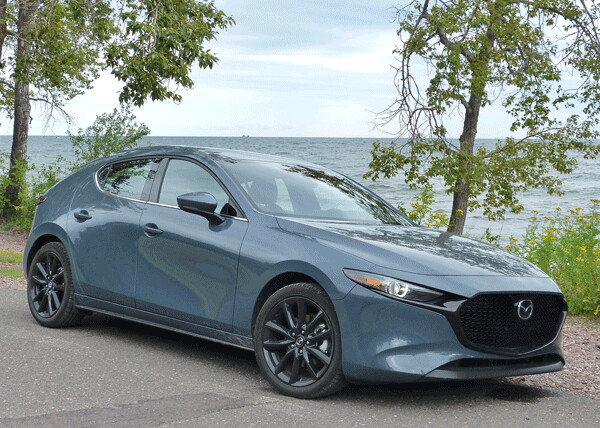
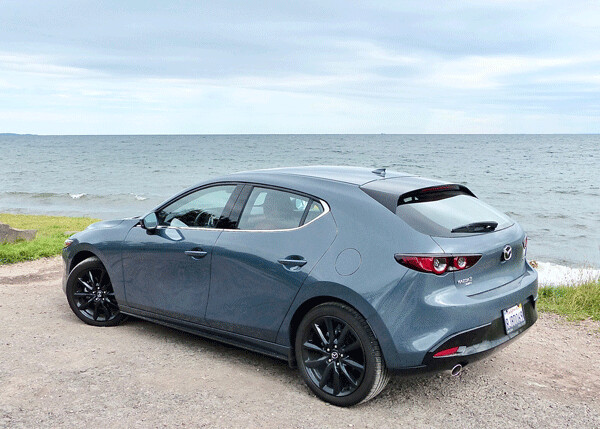
Ever since Mazda decided to revise its entire line and change the compact Protege’s name to Mazda3, it has been among my favorite cars in the world. Smooth and well-proportioned lines, great handling balance, and the legendary “zoom-zoom” Mazda engine technology that provided more content than its price would indicate.
For three generations, the Mazda3 has set a new standard among compacts, even including the stalwarts, Honda Civic and Toyota Corolla. The third generation was definitely the best of those, adding the incredible technology of Skyactiv engineering, and it didn’t seem that Mazda needed to come out with another new generation quite yet.
But the little company from Hiroshima had some new technology it wanted to put together and it was impatient for a new model to properly house it, so the fourth generation hit the showrooms for 2019. And I can’t disagree with the decision, because the new sedan looks like a Mazda6 that wasn’t shrink-proofed, and the new hatchback is my new favorite. It has a sort of elongated occupant compartment and from the rear corner, it looks like it might be a compromise between a car and an SUV.
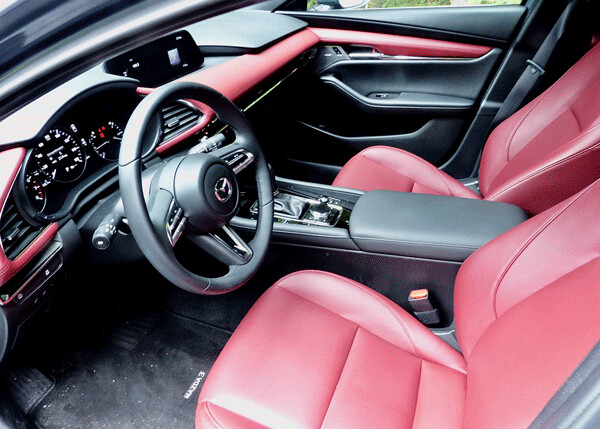
It is, of course, too low-slung and sporty to be an SUV, but the cargo room under the hatch is remarkable, and you can flip down the rear seat backrest and expand it more. One of the more notable additions is all-wheel drive, which lifts the Mazda3 up above its prime competitors like the Civic, Corolla and the revised Hyundai Elantra GT.
Here’s the only downside: The Mazda3 always has been a bargain in the compact segment, offering sophisticated features you might not expect in a compact. For 2019, it might be departing the “bargain” status it always has enjoyed, simply because the technology is so advanced that it caused a rise in sticker price to take care of the technology.
Mazda’s intention is that since it has some advanced technology showing up across its well-appointed lines, it would attempt to move into the “near-luxury” edge of the market. No more bargain-basement stuff. Can’t say that I blame them, especially if you examine and appreciate the engineering.
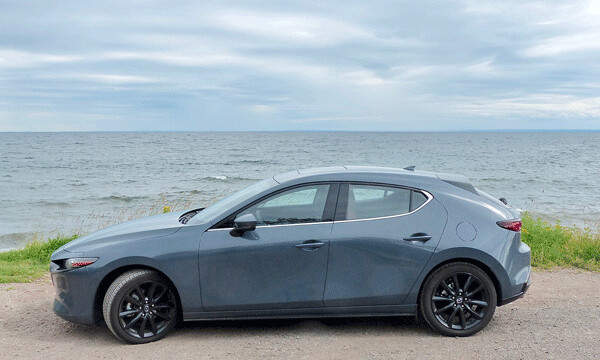
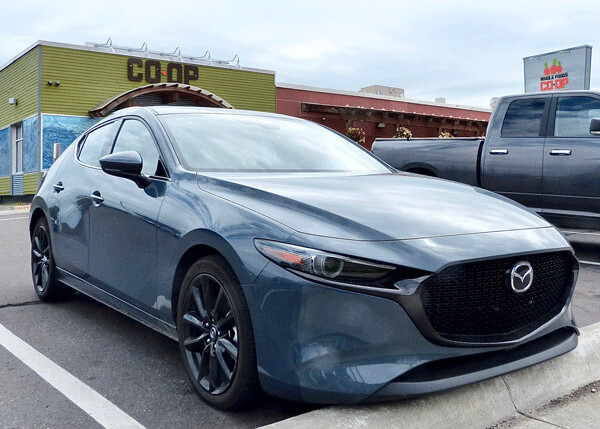
I just drove a 2019 Mazda3 Hatchback in Polymetal Gray Mica, with a surprising red interior, and the Premium Package goodies, and they are very impressive. Almost all of them, that is. Hand-to-hand combat with the radio controls took us most of the week, and gone are the good-ol’ days when a Mazda radio featured three buttons on either side of a large centralized knob. Push the knob and the radio comes on, turn it and you increase or decrease the volume, and the three buttons on either side are presets. What a concept! We don’t have time to discuss all of our gripes with the new Bose 12-speaker audio, which is very good, unless you try something as outlandish as changing the station, or switch from AM to FM or satellite. Coordinating your smartphone with the car also is more complex than most others, but if you owned it, you’d set it and never change it.
Climb into the comfortable and supportive driver’s seat, and you’re immediately impressed by the very feel of the steering wheel, and the gauges on the instrument panel. The console is classy in gloss “piano” black, housing the shift lever for the 6-speed automatic. No CVT for the Mazda3; these guys are zoom-zoom to the soul. I also appreciate the openness of the dashboard, which seems far away from the passenger, because it is, in a clever design to add to the spaciousness. The padded shelf is not level, but sloped, undoubtedly to leave no motivation for stashing stuff up on it.
There is a high center 8.8-inch navigation screen that houses all the connectivity stuff, including the audio, cell-phones and auto operation details. The car is equipped with radar cruise and all the lane-detection and back-up camera and head-up display on the windshield, blind-spot detection and cross-traffic alert at the rear, among all the latest safety items.
But the reason Mazda3 is worth every penny of the sticker — base $28,900, as-tested $32,460 — is the fully evident proof that this thing was engineered, designed and built by car guys. This wasn’t put together by social-climbing preppies or someone trying to win soft-and-cushy awards.
The prime ingredients are things that will impress hard-core car people, while those who just want a car for transportation without details might have to suppress a yawn rather than make the effort to ponder the various features, let alone the combination of all of them.
First, Skyactiv is not new anymore, but the product of a clean-sheet idea to change the way Mazda was making engines, with an eye on the future. All the high-efficiency tricks were put together, such as Atkinson-cycle valve train timing, which can increase or decrease the timing of opening and shutting the valves for optimum burning of the fuel in the cylinder. Putting all that with direct fuel injection and various other super-tuning ideas means the standard 2.5-liter 4-cylinder engine in the Mazda3 has a 13-to-1 compression ratio, but still calls for regular fuel.
At that, the engine produces 186 horsepower, which is a lot for a compact, but also 186 foot-pounds of torque, which is an even greater benefit because of its pulling power. The horsepower peaks at 6,000 RPMs and the torque at 4,000.
The best-kept secret might be Mazda’s G-Vectoring magic, which is the product of 10 years of engineering and refinement. This uses a computerized control system to govern the front wheels. When you turn sharply into a curve or a corner, you’re driving along and using your instincts for when to turn. The “turn-in,” as it’s called, is as precise as you make it, and if it isn’t perfect, you adjust by counter-steering, or correcting, your trajectory. If you correct too severely, you need to correct again. Actually, that can be fun on a road-racing course, because you induce a little tail-wagging that enhances your feeling of speed.
But on the streets and highways, it gets serious in a hurry. A less-skilled driver who makes a bad turning choice might lose control while correcting and/or over-correcting. The best-handling cars are those that turn precisely as you aim them, or are easily corrected when you miss.
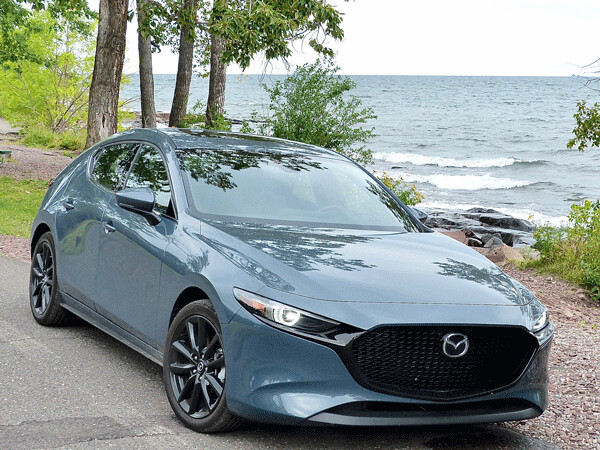
Mazda’s engineers worked trial and error tests and ascertained that when a driver starts to turn in, the car should respond precisely, and while it seems counter to instincts, the G-Vectoring system does two things at the first millisecond’s recognition that you’re making a turn. First, it softens the shock absorber on the outside front wheel for a millisecond — while instinct says you might want to stiffen it. Second, the computer reduces the torque to the outside front wheel, again, for just a couple milliseconds, then returns to normal. By doing those two things, the car’s outside front tends to bob down ever so slightly, and you certainly don’t feel it, but it does convince you that you’ve chosen the right turn-in.
The astounding thing is that the only thing you notice is that you’ve zoomed around the corner or curve as though on rails — with no correction needed. You just keep going, with no skidmacks or screeching of tires.
The third thing is the all-wheel drive system. Mazda has had an impressive all-wheel drive system for its CX-3, CX-5 and CX-9 SUV fleet, but it chose not to use the same system for the Mazda3. Instead, its computer calculates the vertical load on each wheel and combines it with the vehicle’s speed, your steering tendency, and uses an accelerometer and a yaw-sensor to calculate if a potential spin is threatened. When it senses it, the system seamlessly puts all four wheels to work for optimum traction. If it senses no potential slippage, it sends more torque to the rear wheels than the front, aiming at better traction in normal weather.
The six-speed automatic is geared for cruising, and it doesn’t have the neck-snapping off-the-line power some rivals might have, but it’s set up to run efficiently at highway speeds. There are shift paddles on the steering wheel, which allows you to downshift for more revs if you need instant power, or to upshift manually if you choose.
Some of those features can surprise you. For instance, I was driving along on some city streets and it started raining. Not heavy, but just a sprinkle, and while I was thinking about whether I should reach for the wiper switch, the wipers came on! Rain-sensing, they kept up a pretty good pace until the sprinkles ended. Handy.
One of my quarrels with the changing style of testing and analyzing cars is that social media types have taken over, pushing some legitimate and long-standing auto writers off of the manufactures’ lists for invitations to the introductions of new cars. I’m among those, and it bothers me because I always seek out the inside stories of engines, or design features, so I can relay them to readers. Many of the new-age auto writers seem to care more about how soft the dashboard is than new engine technology, and certainly more than suspension refinements.
With that as a preface, I submit Exhibit A as the August, 2019 issue of Car and Driver magazine. Always in a monthly duel with Motor Trend to be the trusted source of auto news, C and D has always had a chippy, irreverent approach to covering cars that I’ve enjoyed, although in its last regime that changed, in my opinion. For August, there is a comparison test of the manual transmission versions of the top compacts. After describing pluses and minuses of each, the magazine ranked the Toyota Corolla fifth and last with 157 points on the various criteria, the Volkswagen Golf SE fourth with 189, the Hyundai Elantra GT third with 192, the Mazda3 second with 194, and the Honda Civic as the winner with 196.
Reasonable, and 196-194 is certainly close. In the evaluation, the Mazda3 won the vehicle section, and the powertrain segment. But as it usually does, Car and Driver gave the Civic a 2-point edge over the Mazda3 in steering feel and brake feel and a 3-point edge in handling, while Mazda had a 1-point edge in ride. The total for that segment they call “chassis” and I consider subjective showed the Civic with best 55 points and the Mazda3 second-worst 48. Still, that would have made the Mazda3 the overall winner, but for good measure, the magazine’s most-subjective item is “fun to drive,” where the Civic scored 23 and the Mazda3 only 16. When the final margin was only two points, and the winner beat the runner-up by seven in the opinion of which was more fun to drive, my suspicions remain.
That in not way diminishes the Honda Civic, which is an outstanding car, as is the entire field. In fact, it might win this competition straight up, without the subjective-points bonus. My complaint comes from writer Annie White, assigned to put it all together for my trusted hard-core car magazine.
She wrote that the Mazda3 faltered because it “isn’t that fun to drive anymore,” and that it “isn’t the great driving car it used to be,” and her conclusion takes the cake. “It doesn’t stand up to hard driving quite the same way,” and she quoted a fellow writer as saying, “This is a car that reels worse the harder you drive it.”
OK, everyone can have an opinion, and they can vary. I totally disagree with the statement that it doesn’t handle, and handles worse in hard driving, or that its steering lacked feel. My issue is that never was there any mention of the unique G-Vectoring, and never did these hard-charging, macho sporty drivers mention — or apparently notice — the absolute and complete lack of ever needing to correct the steering wheel in hard cornering.
Now, the test car I drove was all-wheel drive, and Mazda only offers the stick shifts in the top of the line Mazda3 model. But I’ve driven the front-wheel drive Mazda3 that these folks tested for their comparison, and it might handle a little sportier than the AWD model because its a little lighter.
My bigger question is whether the C and D staff members have shifted their objective and have all joined the purveyors of padded dashboards while no longer noticing or comprehending some major technical advancements.
| Tweet |


